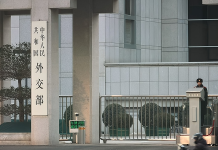
Located in the southeast corner of Norbulingka Palace Park in Lhasa, the Xizang Museum stands out as a facility integrating contemporary technology, design and practices with the regional characteristics of Xizang Autonomous Region, southwest China. The museum houses over 520,000 cultural relics, including silk pieces, religious instruments, ancient books and documents, porcelain and jade articles, enamel vessels, and silverware, as well as Thangka paintings—traditional Tibetan Buddhist scroll paintings.
Among the collections, some have recently been given a new lease on life. These include the timepieces restored by a team from the Palace Museum in Beijing.
The timekeepers’ keepers
The Palace Museum, also known as the Forbidden City, was China’s imperial palace between 1420 and 1911. The museum houses over 1,500 antique timepieces. As the fourth generation to repair and restore antique clocks at the museum since the founding of the People’s Republic of China in 1949, Qi Haonan has restored more than 100 timepieces to their former glory. Repairing ancient clocks is not an easy feat, even for Qi, who majored in mechanical automation at university. “Antique clocks are not only timekeeping tools but also complex machines and objects with a certain function, not to mention that most of them are unique pieces,” he explained.
In Qi’s view, the greatest challenge in restoring the antique timepieces lies in the absence of reference materials. Only through repairing different types of timepieces to accumulate experience, can one master this craft. “It usually takes months—sometimes up to a year—to complete the restoration of a single clock. Even the shortest repair time lasted a whole month,” he told Beijing Review.
In addition, the restoration should be conducted following the principle of minimum intervention—the damaged parts should be repaired with traditional manual techniques, and the missing parts should be duplicated according to their original looks. Moreover, restoring these timepieces doesn’t mean making them look brand new. “The newly added parts are polished to ensure the overall aesthetic consistency. Through cleaning and repairing, I try to maintain the original appearance of the antique clocks, and bring back their mechanical and performance functions,” he elaborated.
“Through the work of our restorers, mechanical clocks that have been still and silent for more than 100 years are brought back to life. Witnessing the moment they start ticking again is the most fulfilling,” he added. “Besides, the functioning clocks can be better preserved.”
According to Qi, the restoration of timepieces at the Palace Museum is the only traditional undertaking that has been passed on continuously. To better pass on the necessary skills, the museum has set up joint antique timepiece restoration rooms across different museums nationwide to repair the still clocks and train professionals in this field. “After learning that the Xizang Museum also owns a large collection of timepieces, we took a special trip to Xizang to gather more information about the situation there,” he said.


Time on the highland
Following a field investigation in 2023, the Palace Museum and the Xizang Autonomous Region Bureau of Cultural Heritage jointly established a restoration room at the Xizang Museum, aiming to restore its collection of nearly 300 antique timepieces. “The collection covers a wide range of complex boutique clocks from different countries, including Germany, Japan, the United States, Switzerland, and France. Moreover, some clocks were once owned by very special people. So exploring them is of great historical and cultural value,” Qi said.
The project officially got underway this year, with plans to send teams to Xizang in phases over the next decade to carry out restoration work.
“The timepieces collected by the Xizang Museum mainly date back to the late Qing Dynasty (1644-1911). Most of them were gifts given by the central governments of the Qing Dynasty and the Republic of China (1912-49) to the local political and religious elites of Xizang, demonstrating the effective administration of Xizang by the central governments,” Wei Guo, Director of the Cultural Relic Science and Technology Protection Center at the Xizang Museum, told Beijing Review.
Qi and his team were part of the second batch sent to Xizang. He noted that the restoration work there was largely similar to that in Beijing, aside from the challenges posed by altitude sickness—and the lack of tools.
“Before the program was even launched, my mentor Wang Jin and I had already conducted a preliminary assessment of all the clocks in the Xizang Museum, evaluating their damage levels, and formulating corresponding repair plans. But despite our thorough prior research and preparation, the tools available were still insufficient. Only when the machinery is disassembled can we fully assess the extent of the wear and tear on the clocks and determine if there are any missing parts. Due to the limited equipment, repairing parts required manual craftsmanship, which may demand more time and energy,” Qi explained.
“After professional restoration, the long-dormant collection in the warehouse finally comes back to life,” said Wei, adding that the expert techniques and rigorous and standardized steps of the Palace Museum experts will set an example for the restoration team of the local museum.
Reviving relics
According to the Xizang Museum, the restoration project in cooperation with the Palace Museum is not an isolated effort. Over a decade ago, with support from the National Cultural Heritage Administration, the Xizang Museum began actively seeking collaboration with cultural institutions and museums nationwide. This initiative intended to gain access to technical support and service platforms within the cultural heritage sector, enabling local restoration work to be conducted within the region.
For example, from 2014 to 2017, in collaboration with the Shaanxi Institute for the Preservation of Cultural Heritage, the Xizang Museum assisted in the rescue and restoration of over 200 sets of Buddhist statues and cultural relics at Densa Thil Temple in Shannan Prefecture. Another collaboration involved the conservation and restoration of five Thangka paintings and four textile pieces in partnership with the China National Silk Museum.
In addition to these physical restoration efforts, the Xizang Museum has also teamed up with the Data Center of the National Cultural Heritage Administration to digitize its collections.
“In the future, the Xizang Museum will continue to work with partner entities, including the National Museum, the Palace Museum, the Shanghai Museum, the Shaanxi Institute for the Preservation of Cultural Heritage, the Hunan Museum and the Dunhuang Academy, to further implement restoration projects, research on traditional restoration techniques; and train more professionals, thereby bringing more cultural relics back to life,” Wei said. –The Daily Mail-Beijing Review news exchange item





